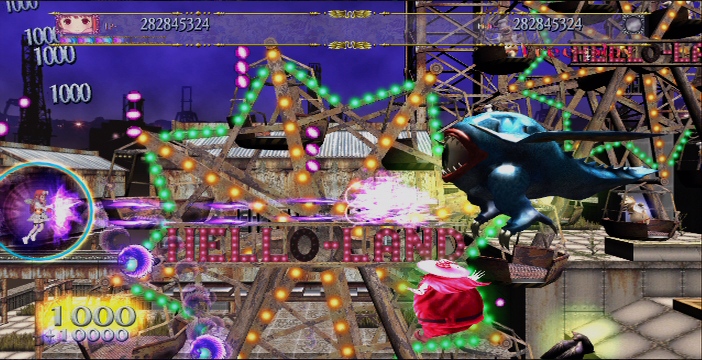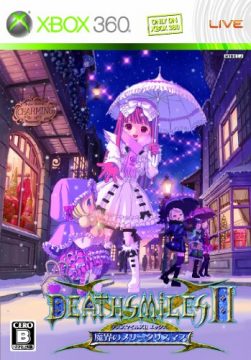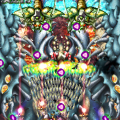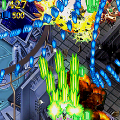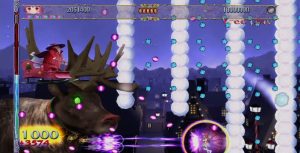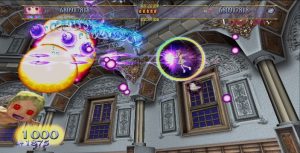- Deathsmiles
- Deathsmiles II
Object if you must to Cave’s less-than-subtle expedition into some squeamish marketing territory with Deathsmiles, but the results speak for themselves: the game was a hit both in arcades and on the 360, so the developer was obviously eager for a second go-round. As the title of Deathsmiles II: Makai no Merry Christmas (which might be translated “The Netherworld’s Merry Christmas” or possibly “Merry Christmas From the Netherworld”, which just sounds cooler) suggests, the Halloween-inspired imagery of the former has been partially supplanted by a Yuletide theme; no need to worry, though, as there are still plenty of demons and monsters hanging around, all in dire need of a good blasting.
As we rejoin our heroines, winter has arrived in Gilverado, and the “angels” have been feverishly working to bring their favorite “real-world” holiday to their new surroundings; thanks to their efforts, festive displays of tinsel and colored lights line the streets. On Christmas Eve, however, tragedy strikes, courtesy of a creepy, evil, long-nailed version of St. Nick known as Satan Claws (yes, really), who has escaped from the spirit world to exact revenge on Count Dior for a past defeat. The cackling villain flees the angels’ mansion with a stolen set of Dragon Ball-esque wish-granting golden music notes, leaving the old man critically wounded in his wake: the girls quickly take flight to avenge their benefactor and get his stuff back. Well, some of them, anyway: Windia and Casper return in much the same form as before, but Rosa and Follett, despite appearing in the story, are no longer playable. Taking their places are two new allies, who do their darnedest to make prospective players even more uncomfortable with themselves than the original group did.
Characters
Supe
Looks like Casper’s been forced to surrender her coveted title of “youngest angel” to this pint-sized ragamuffin from Copenhagen. While skating on a frozen pond the ice beneath her feet suddenly gave way, and next thing she knew she’d landed in Gilverado: Windia encounters the cold and frightened Supe (sometimes mistranslated as “Soupy”) on the street and invites her home to meet the Count, but Satan Claws had found her first, and was watching. Upon arrival at the mansion the girl’s newfound powers are forcibly usurped, and Dior is savaged; after Claws runs off with the loot Supe returns to normal and volunteers to help right this wrong. Her familiar, believe it or not, is the ghostly remnant of Tyrannosatan from the first game, who bestows strong offensive power but somewhat limits her scoring potential. Supe’s design appears partially inspired by the old Hans Christian Andersen tale of “The Little Match Girl”.
Lei
Cue Admiral Ackbar! Lei (sometimes mistranslated as “Rei” or “Ray”) is not, in fact, a girl at all, but a boy in drag: to be precise he’s Supe’s older brother, who desperately tried to save her from the frigid water but ended up meeting the same fate. After appearing in a distant part of town, a bum named Goldberg happens upon Lei and lends him the only dry clothes he can get: a maid uniform. Sensing a possible opportunity, he instructs the boy to keep the disguise and apply for a job with Count Dior to bring in some much-needed pocket money: the pair arrives on the scene just in time to see Supe take off with the angels. Lei immediately determines to follow… but neglects to change his getup first. He uses two familiars simultaneously (twin angels, blonde Pipi and dark-haired Pepe), much as Sakura did before him; in contrast to Supe his attack damage is weak, but he can spawn lots of items and rack up points easily.
The first thing you’ll notice about the sequel is an abrupt stylistic overhaul in the visual department: Joker JUN is back at the design helm (and contributes another boss’s voiceovers), but II‘s artwork is a departure from the original’s, sporting a more “airbrushed” and “cutesy” look, which plays down the former’s darker aspects and lends the characters an even younger vibe. A far more striking shift, though, has taken place in-game, the result of a sudden switch from Cave’s standard SH3 arcade hardware to a custom PC-based setup (which, interestingly, arcade operators had the option to “rent” instead of buy outright, a first for the company): no, your eyes do not deceive you, those are honest-to-goodness polygons. And no, this is not Cave’s first-ever attempt at 3D graphics, though you might be forgiven for thinking so.
To put it kindly, the game’s models and environments are years behind the curve; certain elements in particular might as well be holdovers from the 32-bit era. The colorful bullet patterns and explosions do still look good, and a few noteworthy touches are present (if you look closely, the “flying book” enemies in one level bear the title “History of danmaku Shooting Game” on their covers), but on most fronts the visuals simply don’t hold a candle to their sprite-based forebears in either charm or technical merit.
Also returning for an encore is composer Manabu Namiki, whose music makes a much more graceful transition, thankfully – while classical and techno elements were freely mixed together in the first game, here they tend to manifest themselves separately, with most tracks leaning decidedly in one direction or the other. Individual preferences may vary, but these newly “focused” scores complement the action just as capably as their ancestors: in further keeping with the series’ spirit, of course, wacky remixes of “Joy to the World” and the Bach/Gounod “Ave Maria” are in here too.
Craggy preview screenshots notwithstanding, a number of fans shrugged off the nay-saying “graphics whores” among them and eagerly headed for the arcades to give the sequel a spin: even most of the true believers, however, were utterly aghast at the regressive restructuring awaiting them there. Only five stages total stand between the attract screen and the end credits (no hidden/unlockable extras, either), with only the middle three playable “out of order”; even worse, the much-lauded “challenge adjust”, which above all else established Deathsmiles‘ brand as a more “inviting” breed of shooter, has been nixed completely.
While the game’s overall difficulty level, to be fair, is somewhat on the low side compared to Cave’s previous output, returning patrons too inexperienced for the default settings are still in for a humbling few minutes (if that) at the cabinet. It’s rather difficult to guess what the designers were thinking in shackling such restraints upon a series so recently and successfully built on openness, but across nearly a half-dozen “revised” editions of Deathsmiles II released to arcades these elements were left entirely intact; the development team certainly wasn’t acknowledging any miscues on their part.
With so much going against it right off the bat, is there any reason to delve further into this misshapen younger sibling? Believe it or not, if given half a chance to show it, Deathsmiles II is genuinely fun to play, warts and all – while the first game’s basic “shoot left/shoot right/lock shot/bomb” control mechanics are fundamentally unchanged, Cave has tweaked everything a bit, and thankfully did a much better job here than on the frontend.
For starters, your lock shot can now latch onto multiple targets at once, making it a much more practical weapon than before, though its range is now dependent on your current item count, and will shrink when overused; moreover, attacking enemies (especially large ones, bosses included) at point-blank range awards additional items, in similar fashion to Ketsui and Mushihime-sama Futari, among others. These seemingly minor changes add an extra “risk/reward” dimension to one’s positioning and offensive strategies, not to mention a fresh approach to high-score runs: the scoring system, speaking of which, has received an even bigger (but similarly positive) overhaul.
The “main” and “overall” counters from the first game are still here and work much the same way, but now each one can be built up simultaneously and “on demand”: when using most (though not all) characters, hitting ANY adversary with “normal” shots spawns collectable red rings (which add to the “main” item counter), while “focus” shots create blue rings (which increase the “overall” point multiplier). In essence, instead of being forced to use certain attacks against certain enemies to maximize your rewards, you’re free to change up your offense any time you decide you want (or need) one type of boost or the other, as well as bolster the multiplier before powering up and cashing in.
The lock shot also factors into your tactics more centrally than before: for one thing, certain enemy targets now hide out in the background, and can’t be hit with any other weapons (think Rayforce or Soukyugurentai). Moreover, if you keep the lock circle activated after destroying a baddie (or several), the deceased will release homing “suicide bullets” which follow you relentlessly until you release the lock. Summoning forth these additional hazards is risky, but once you do let off the buttons the extra bullets will be cancelled into bonus items (including gaudy diamond rings, this game’s equivalent of the original’s gold crowns), and can thus help to fill you up much faster if exploited wisely.
Once you’re in “power up” mode with a maxed multiplier, those diamonds (and points) start flowing like nobody’s business, and a timely “recharge” can be executed much more easily than in the first game. By the way, items don’t “bounce and split” anymore, so feel free to just grab ’em all as soon as they appear: finally, your “overall” multiplier no longer resets once power-up mode ends (though it gradually drains during boss fights), so if you can boost it early and avoid bombing or dying you can ride it out for a good long time.
Deathsmiles II is also helped by the fact that its stages, though spartan in appearance and limited in number, are packed with action: while Deathsmiles was hardly plagued by dull moments, even its highlights can sometimes appear tame compared to those found in the sequel. At times the screen-clogging bevy of baddies, bullets and bonuses can be downright disorienting, but for the most part it’s a welcome rush: finally making it all the way to the top of the giant well in the Ruins unscathed is a great feeling, as is vaporizing the seemingly endless waves of poltergeists blocking your path to the final corridor of the Dead Man’s Mansion.
You might say that, all around, there’s a somewhat more “unhinged” design approach at work than before – the first Deathsmiles could certainly earn itself a “what were they smoking when they made this” award nomination in places, but II’s unique brand of old-style gaming nonsense is in a league by itself. Did that boss just throw his own head at the screen and start puking bullets? How many giant evil possessed chess sets can one villain own? Uh, are those cute red snow boots over there trying to kill me too? (Answer: Yes they are.) If you’re anything but a stone-hearted, unsmiling, “my hobby must take itself 100-percent seriously” gamer, it’s tough not to chuckle a bit as Satan Claws, astride a Godzilla-sized reindeer, screeches a delirious “Merriiii Kurisumaaaaas!” as he blankets the screen in festive seasonal death.
Somewhat predictably, Deathsmiles II‘s uneven blend of steps forward and steps back was greeted with mixed reviews, but the game garnered enough interest to green-light an “enhanced” trip to the XBox 360, somewhat cheesily titled Deathsmiles IIX: for fans expecting a de facto apology for some of Cave’s more questionable moves in the arcades, though, things get off to a pretty bad start. While “Arcade” mode is here, supposedly it wasn’t originally slated to be included on IIX at all, and was basically duct-taped on at the last minute: it shows, as the port lacks most of the features already implemented in the first game’s 360 edition.
Optimized visual settings for non-widescreen displays, replay saving/sharing, online co-op, leaderboards, and any sort of training mode are simply nowhere to be seen, with some nasty bugs taking their place… oh, and did I forget to mention that the “warning” indicators to signal approaching enemies are, for some inexplicable reason, gone too? A few of these issues were addressed (and some new ones cropped up) with a patch later on, but however you slice it this “straight” conversion of the arcade game, while playable, was simply not handled with as much care as it should have been, especially when already-grumpy consumers were not-unjustifiably expecting improvements.
The obvious intended highlights of the package are the two 360-exclusive play modes, both of which are much more polished, at least from a technical perspective. “Deathsmiles IIX Mode” is the first of them, and re-inherits most of the options and trimmings that Arcade mode is missing; it’s also been reoriented to run in full 16:9 widescreen with improved graphics (though still hardly head-turners), additional voicework, and the overdue ability to disable story scenes completely. Rosa and Follett make their triumphant return to playable status as well, though both are perhaps a bit too overpowered compared to everyone else this time around; two new stages (one required, one optional) have also appeared on the map, and another hidden final boss can be challenged, but perhaps most importantly the series’ marquee “difficulty selector” has been reinstated, allowing for much more newbie-friendly gaming sessions when your (open-minded) friends are over.
The basic controls and scoring principles from the arcade edition remain, with a couple of twists. The lock shot no longer drains your item counter when used, but is instead fueled by a separate gauge displayed as a circle around your character; it recharges fairly quickly when left dormant, but abuse the attack and you’ll still be stuck without it for a bit. Even more noticeably, while “power-up” mode lasts longer here, all enemies destroyed in this state release a new type of “suicide bullet”, which initially streaks towards you but slows down when close, leaving you surrounded by hovering threats whenever you gun down a big group.
Getting rid of these annoyances, thankfully, is as easy as activating the lock shot for a moment, which cancels them all into rings, ripe for the taking: the “overall” multiplier now resets when you power down, though, so make sure to time those recharges well. It’s essentially the same “wait ’til the last second for a big payoff” game of chicken as the arcade game, but even more over-the-top; a bit intimidating at first, to be sure, but once you grasp the flow of the action this mode is actually a bit easier to get around in than the original game.
Then there’s “Arrange Mode”, which is a bit reminiscent of Version 1.1 from the first game’s home port: the graphical enhancements, extra content and reinstated difficulty select from “IIX Mode” have been carried over, but success is once again centered around utilizing your familiar effectively. The “standard” lock shot has been replaced with the “option throw” command: as its name suggests, pressing the “throw” button sends out your familiar, who can not only lock on to targets but cancel any bullets it touches into items before returning to its original position. A second press mid-flight summons it back early, while “focusing” slows it down and allows some measure of direct control.
There are no real limits to how frequently you can “throw”, rendering this ability highly abusable, which seems even more like overkill considering that “power-up mode” now activates automatically and you can clear away many enemy attacks with your character’s “normal” bullets – mind you, there are LOTS more projectiles for you to deal with here, especially since collecting blue rings for your multiplier (which, by the way, can go way higher now) builds up a “tension” meter that makes enemies crankier.
In case that wasn’t enough, baddies dispatched via lock-shot spawn heat-seeking, bullet-spewing skulls, which can only be destroyed with the character’s main shot – basically, if you’re doing things “right” the screen will get ludicrously crowded in mere seconds, but can be mopped up just as quickly, to the point where you can stay in so-called “fever” mode almost constantly and milk bosses for extra points with minimal effort. Oh, and destroying bullets and skulls also increases a separate “magic charge” meter, which awards an extra bomb when filled – good luck keeping track of all that without a bit of practice. All in all, while “Arrange” mode makes for quite the spectacle, some may find it too gimmicky and slow-paced to compete with the disc’s other offerings.
You might also notice an “Extra Mode” listing on the main menu, but this isn’t actually another mode at all – it’s a mini-game titled “Tsukaima Race”, in which you roll and bounce one of the game’s “familiar” helpers through a series of obstacle-ridden 2-D mazes decorated with scenery from the first Deathsmiles. Each of the little buggers has different characteristics (speed, jump, etc.) which make some better-suited than others for quick clear times on certain levels; before you ask, yup, this thing has its own leaderboards (plus a handful of Achievements), and completing it with every character unlocks a bit of gallery artwork, but despite the fact that this diversion can be enjoyable for a short time when the mood strikes you (the somewhat imprecise mechanics sap the charm away before too long), most players will wish that less time was spent on this fluffy fan service and more was devoted to making the “core” modes (particularly Arcade) the best they could be.
In any event, all first-print IIX customers received a DLC voucher (mistakenly marked with a “Deathsmiles III” logo) for an extra in-game music track, while Limited Edition purchasers again got different cover art and a soundtrack CD; those who ordered directly from Cave’s online store scored a phone card too. True devotees can once again fork out for an array of Gamerpics and a theme or two from Japan’s XBox Live Marketplace (downloadable character costumes were apparently considered, but eventually abandoned), keychains or the official artbook.
Those who need to immerse themselves even further can snag a second themed arcade stick from Hori, or even download an i-mode cell phone offshoot, starring Supe, titled Deathsmiles Gaiden. Only the creepiest and/or least inhibited, however, might have sprung for ANOTHER flyer-printed papercraft game which involves blowing off a character’s clothes, or a dark purplish beverage labeled “Windia’s Dark Urine“, sold at one of the company’s bi-annual “Festival” events. Although Deathsmiles II did not receive an official localization, it was released digitally worldwide through the Xbox Live Arcade service, though the language is still in Japanese.
Unfortunately, a cavalcade of not-unjustified negative impressions were enough to swear more than a few vengeful Cave fans off of Deathsmiles II forever, but shmuppers of all stripes really ought to give the sequel a fair shake and judge for themselves – so long as they’re reasonably aware of what to expect, good and bad, odds are they’ll end up pleasantly surprised.
